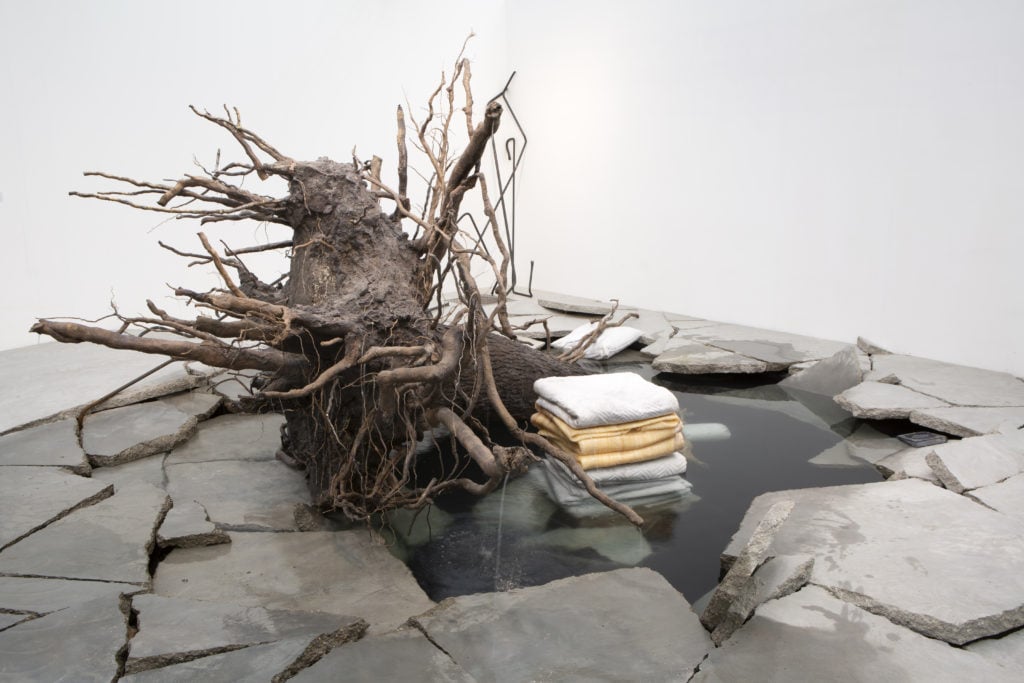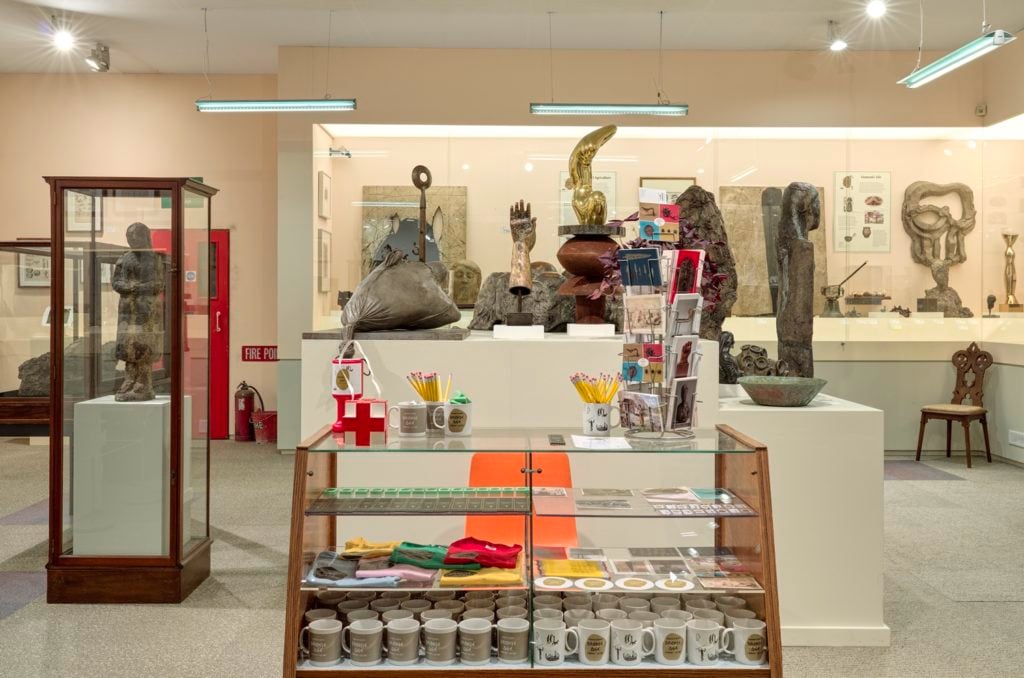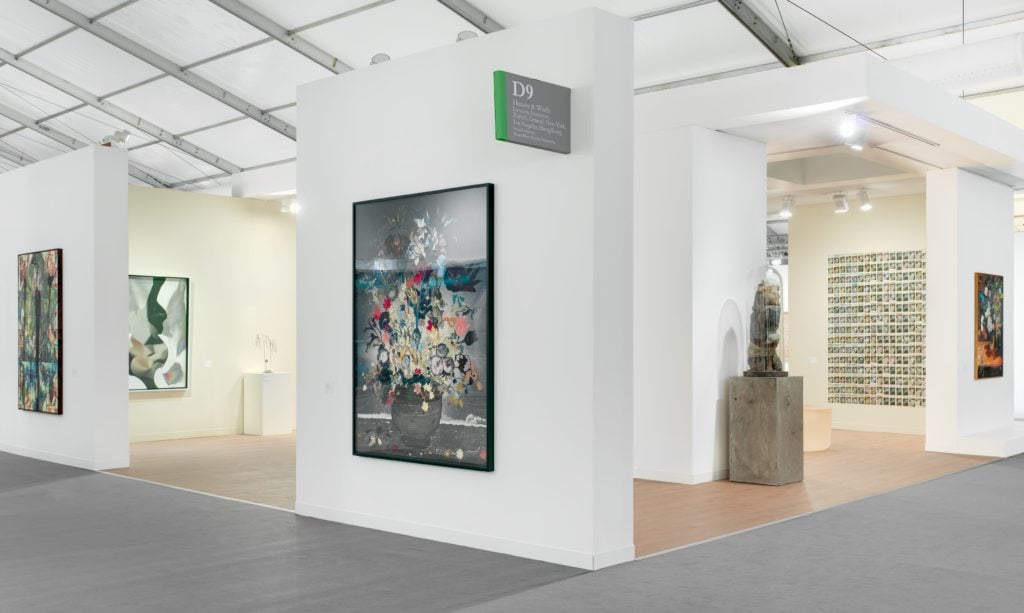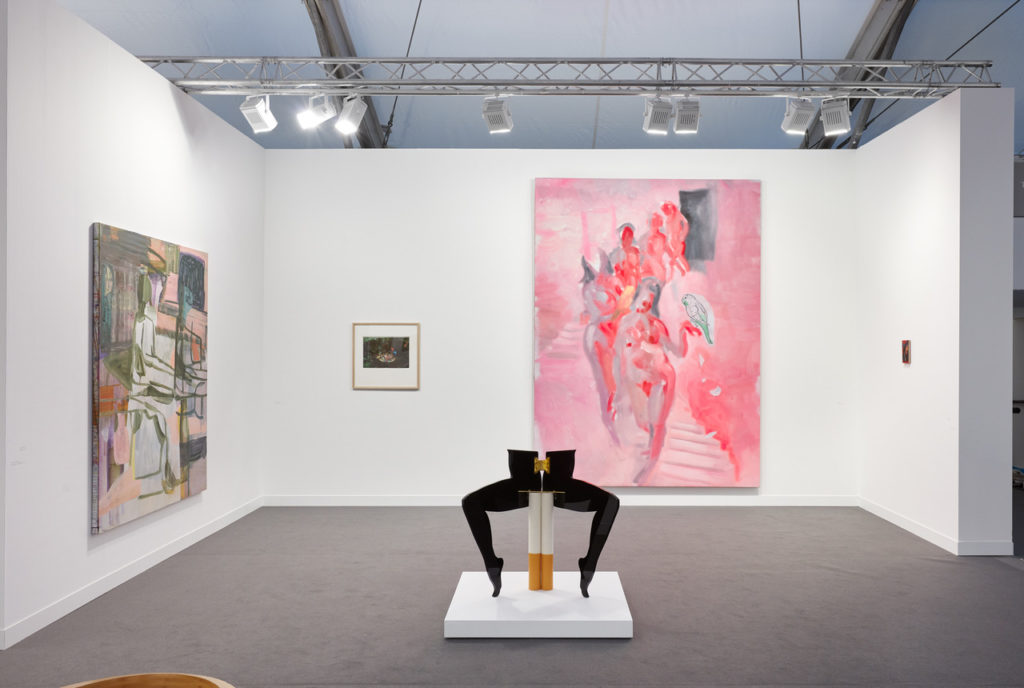Art Fairs
‘Everybody’s Hedging Their Bets’: At Frieze London, an Uncertain Art Market Makes the Fair Less Fun (With a Few Exceptions)
It's out with the shock of the new, in with the tried-and-true.

It's out with the shock of the new, in with the tried-and-true.

Julia Halperin

Like that friend who starts planning her Halloween costume in June, Hauser & Wirth tends to enthusiastically and elaborately dress up for Frieze London. Last year, the gallery invited classics scholar Mary Beard to transform its booth into an imaginary regional museum, complete with linoleum floors and a fully functioning gift shop. Back in 2014, the artist Mark Wallinger turned the stand into an approximation of Sigmund Freud’s study.
This year, however, the mega-gallery decided to do something a little different. Out: theatrical lighting and vintage furniture. In: muscular paintings by gallery mainstays including Mark Bradford, Günther Förg, and Matthew Day Jackson; pristine white walls; and clean wood floors.
“The working title is of the display is ‘Works I’d Like to Live With,’” the gallery’s senior director Neil Wenman told artnet News dryly on Thursday. “We brought it back to the reason for an art fair—to buy something you’d like to live with.”

Frieze London 2017: An adventurous Mary Beard-curated booth at Hauser & Wirth. Photo by Alex Delfanne, courtesy of the artists, estates, and Hauser & Wirth.
Hauser & Wirth isn’t alone. At a time when the market is measured, Brexit is looming, and the gap between the top and the bottom is yawning ever wider, dealers at Frieze London are, by and large, going back to tried-and-true basics.

Frieze London 2018: Hauser & Wirth’s much more conventional booth. Photo by Alex Delfanne. Courtesy of Hauser & Wirth.
“Fairs are used for one of two things: either direct business or as advertisements,” notes Christian Ehrentraut of Galerie Eigen + Art. These days, the former, short-term goal—which lends itself to paintings and other easily tradable work—seems to be winning out over the latter, which encourages flashy but impractical installations in the vein of Hauser & Wirth’s regional museum set.
So far, the straightforward strategy has proven reasonably successful. Hauser sold a collage by Rashid Johnson for $215,000, three paintings by Förg for prices beginning at €350,000 ($402,470), and a screenprint by Lorna Simpson for $375,000, among other works. Thomas Dane sold a juicy abstract painting by Cecily Brown for $450,000, while Timothy Taylor Gallery swiftly sold out its stand of new paintings by Eddie Martinez priced at $30,000 to $95,000.
To be sure, there are exceptions to the prevailing vibe. Kamel Mennour is presenting a hugely ambitious installation by the artist Tatiana Trouvé, which looks as if a giant upturned tree landed like an asteroid in the middle of a concrete room. (The project, priced at €650,000, was originally conceived for a biennial, but was deemed too impractical to install.) Meanwhile, Stephen Friedman’s solo presentation dedicated to the wry artist David Shrigley includes a closet-size space for a work of sound art—a serious flex for an art fair that charges by the square meter.

Lisson Gallery booth at Frieze London. Courtesy of Lisson.
London’s Lisson Gallery, which in 2013 gave over its entire booth to a single freestanding glass sculpture by Dan Graham, has landed somewhere in the middle on the practicality spectrum. It brought paintings and photographs alongside a series of less-buyer-friendly films, all of which are loosely tied to the theme of “performing the self.” By the end of the second preview day, the gallery had largely sold out of the works it brought by artists including Laure Prouvost, John Akomfrah, and Ryan Gander, which were priced from $12,000 to $86,300.
Lisson’s Ossian Ward acknowledges that for most dealers—particularly those who aren’t based in London—“the economics don’t allow you” to take chances. After shelling out hundreds of thousands of dollars to rent a booth, ship works, and put your staff up in hotels, “how else are you going to make a return on your investment?”
Another sign of the shifting market: While Frieze London has historically been a destination for fresh-from-the-studio work, dealers are increasingly taking precautions by combining brand new contemporary fare with proven vintage material.
“Everybody’s hedging their bets,” says David Nolan Gallery’s Alva Stux. Today, mom-and-pop galleries and megas alike “want to have a strong secondary program and a hot contemporary program.” At Frieze, David Nolan is presenting drawings from the ‘70s by artists including Jim Nutt and Fred Sandback alongside new paintings by younger artists like Jonathan Meese.
A similar strategy is evident at Kavi Gupta, where a vibrant work by the 29-year-old artist Devan Shimoyama hangs alongside works from the ‘70s by AfriCOBRA artists. (Stretching even further back in history, the gallery has a work by Russian expressionist Wassily Kandinsky in a back room.)
Thomas Dane injected a dose of history into its display by juxtaposing a 2018 painting by Dana Schutz ($350,000)—which was so new that the paint wasn’t even dry when it arrived—with a political drawing from the 1930s by the German satirist George Grosz (€58,000).

Thomas Dane’s booth at Frieze London. Photo: Luke A. Walker, courtesy of Thomas Dane Gallery.
“People are looking to show work that has credibility—stuff that can be contextualized,” observes Ethan Buchsbaum of Almine Rech, which presented luscious resin sculptures by De Wain Valentine and saturated color-field-style paintings by Vivian Springford from the ‘70s alongside newer abstract paintings by John Armleder and Förg. “Fairs are becoming more about showing the best examples of artists as opposed to the newest. There’s less emphasis on the shock of the new.”
The tick-multiple-boxes approach is visible in price point as well. “It used to be that small galleries offered affordable art and big galleries sold expensive art,” Stux says. “Now, established galleries are trying to get new collectors and older galleries have bills to pay.” (Notably, Ossian Ward described Lisson’s entire booth as “not particularly high-ticket.”)
The shift to stable ground was particularly evident in the Focus section, which is devoted to galleries 12 years old or younger and is often a destination for experimental, new media, or performance-based work.
“I was quite astonished by the amount of plain things that came out of that section,” the collector Alain Servais tells artnet News. He is sympathetic, however: The stakes are high enough and the margins small enough that galleries must “bring down the offerings to a lower common denominator.”
Some participating dealers acknowledge this as well. “The committee is realizing that we can’t just be edgy—we need to bring commercial work so we can sell too,” one dealer says. “It’s a totally different fair experience having works that are commercially viable.”
Other participants don’t feel they are compromising so much as putting their best foot forward to attract new clients. “There is a sense that people have to sell—it doesn’t mean they have to show the easiest things, but they have to show the material in the best possible light,” says Jeffrey Ian Rosen of the Toyko-based gallery Misako and Rosen. At Frieze, he sold out of petite geometric paintings by Yui Yaegashi priced between $2,700 and $4,250 and sold two of three floral paintings by Miki Mochizuka for $8,000 each.

Julie Curtiss, REP (2016). Courtesy the artist and Various Small Fires, Los Angeles
Another gallery in the section, Various Small Fires, swiftly sold two figurative paintings of women’s hair and nails that look like a twist on Domenico Gnoli by the young New York-based painter Julie Curtiss for $10,000—one to a Korean Foundation and one to the private M Woods Museum in Beijing. There are dozens of people on the waiting list for her work, which has already been acquired by the Los Angeles Museum of Contemporary Art and the Walker Art Center, says the gallery’s Esther Kim Varet.
While some might decry the lack of booths that look like they were conceived by a Tony Award-winning set designer, others are sanguine. After all, fairs have always been, ultimately, about sales. “Art fairs are not places to see ‘experimental work,’” says the art advisor Todd Levin. “That is the place of both museums and galleries themselves, where the emphasis is more educational than transactional.”
Frieze London is open in Regent’s Park in London through October 7.